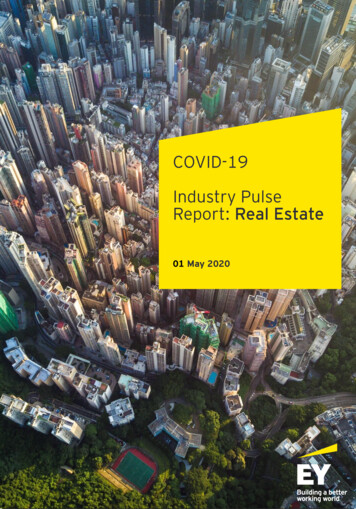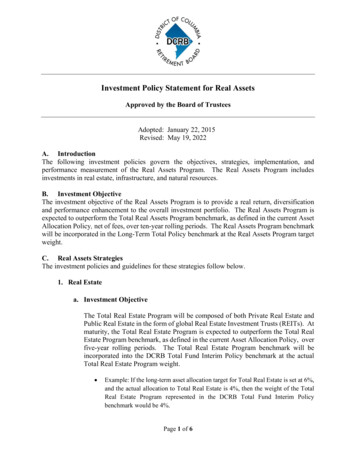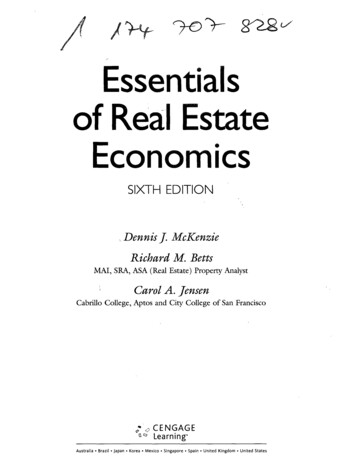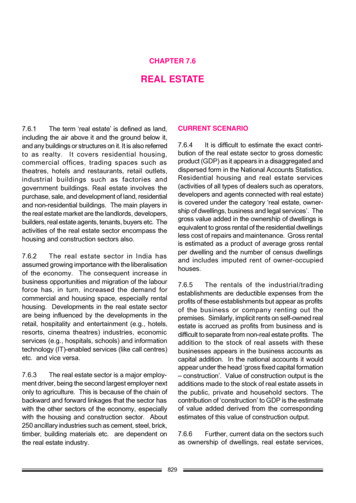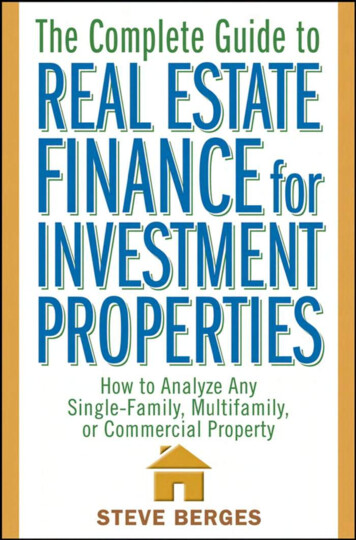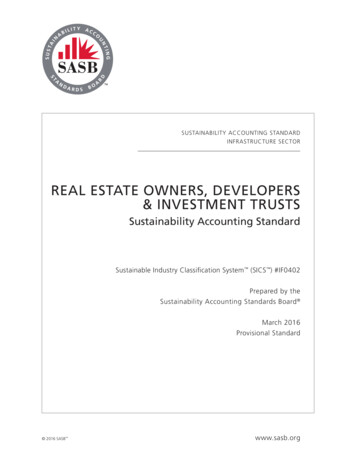
Transcription
SUSTAINABILITY ACCOUNTING STANDARDINFRASTRUCTURE SECTORREAL ESTATE OWNERS, DEVELOPERS& INVESTMENT TRUSTSSustainability Accounting StandardSustainable Industry Classification System (SICS ) #IF0402Prepared by theSustainability Accounting Standards Board March 2016Provisional Standard 2016 SASB www.sasb.org
REAL ESTATE OWNERS, DEVELOPERS& INVESTMENT TRUSTSSustainability Accounting StandardAbout SASBThe Sustainability Accounting Standards Board (SASB) provides sustainability accounting standards for use bypublicly-listed corporations in the U.S. in disclosing material sustainability information for the benefit of investorsand the public. SASB standards are designed for disclosure in mandatory filings to the Securities and ExchangeCommission (SEC), such as the Form 10-K and 20-F. SASB is an independent 501(c)3 non-profit organization.Through 2016, SASB is developing standards for 79 industries in 10 sectors.SUSTAINABILITY ACCOUNTINGSTANDARDS BOARD1045 Sansome Street, Suite 450San Francisco, CA 94111415.830.9220info@sasb.orgwww.sasb.orgThe information, text, and graphics in this publication (the “Content”) is owned by Sustainability Accounting Standards Board. Allrights reserved. You may use the Content only for non-commercial, informational, or scholarly use, provided that you keep intact allcopyright and other proprietary notices related to the Content, and that you make no modifications to the Content. The Content maynot be otherwise disseminated, distributed, republished, reproduced, or modified without the prior written permission of SustainabilityAccounting Standards Board. To request permission, please contact us at info@sasb.org. 2016 SASB SUSTAINABILITY ACCOUNTING STANDARD REAL ESTATE OWNERS, DEVELOPERS & INVESTMENT TRUSTS
Table of ContentsIntroduction. . . . . . . . . . . . . . . . . . . . . . . . . . . . . . . . . . . . . . . . . . . . . . . . . . . . . . . . . . . . . . . . . . . . . . . . . . . . . 1Purpose & Structure . . . . . . . . . . . . . . . . . . . . . . . . . . . . . . . . . . . . . . . . . . . . . . . . . . . . . . . . . . . . . . . . . . . . . 1Industry Description . . . . . . . . . . . . . . . . . . . . . . . . . . . . . . . . . . . . . . . . . . . . . . . . . . . . . . . . . . . . . . . . . . . . . 1Guidance for Disclosure of Sustainability Topics in SEC filings . . . . . . . . . . . . . . . . . . . . . . . . . . . . . . . . . . . . . . 2Guidance on Accounting of Sustainability Topics. . . . . . . . . . . . . . . . . . . . . . . . . . . . . . . . . . . . . . . . . . . . . . . . 4Users of the SASB Standards. . . . . . . . . . . . . . . . . . . . . . . . . . . . . . . . . . . . . . . . . . . . . . . . . . . . . . . . . . . . . . . 5Scope of Disclosure. . . . . . . . . . . . . . . . . . . . . . . . . . . . . . . . . . . . . . . . . . . . . . . . . . . . . . . . . . . . . . . . . . . . . . 5Reporting Format . . . . . . . . . . . . . . . . . . . . . . . . . . . . . . . . . . . . . . . . . . . . . . . . . . . . . . . . . . . . . . . . . . . . . . . 5Timing . . . . . . . . . . . . . . . . . . . . . . . . . . . . . . . . . . . . . . . . . . . . . . . . . . . . . . . . . . . . . . . . . . . . . . . . . . . . . . . 8Limitations . . . . . . . . . . . . . . . . . . . . . . . . . . . . . . . . . . . . . . . . . . . . . . . . . . . . . . . . . . . . . . . . . . . . . . . . . . . . 8Forward Looking Statements. . . . . . . . . . . . . . . . . . . . . . . . . . . . . . . . . . . . . . . . . . . . . . . . . . . . . . . . . . . . . . . 8Sustainability Disclosure Topics & Accounting Metrics . . . . . . . . . . . . . . . . . . . . . . . . . . . . . . . . . . . . . . . . . . 9Energy Management. . . . . . . . . . . . . . . . . . . . . . . . . . . . . . . . . . . . . . . . . . . . . . . . . . . . . . . . . . . . . . . . . . . . 11Water Management . . . . . . . . . . . . . . . . . . . . . . . . . . . . . . . . . . . . . . . . . . . . . . . . . . . . . . . . . . . . . . . . . . . . 23Management of Tenant Sustainability Impacts. . . . . . . . . . . . . . . . . . . . . . . . . . . . . . . . . . . . . . . . . . . . . . . . . 33Climate Change Adaptation . . . . . . . . . . . . . . . . . . . . . . . . . . . . . . . . . . . . . . . . . . . . . . . . . . . . . . . . . . . . . . 38SUSTAINABILITY ACCOUNTING STANDARD REAL ESTATE OWNERS, DEVELOPERS & INVESTMENT TRUSTS
INTRODUCTIONPurpose & StructureThis document contains the SASB Sustainability Accounting Standard (SASB Standard) for the Real Estate Owners,Developers & Investment Trusts industry.SASB Sustainability Accounting Standards are comprised of (1) disclosure guidance and (2) accountingstandards on sustainability topics for use by U.S. and foreign public companies in their annual filings (Form 10K or 20-F) with the U.S. Securities and Exchange Commission (SEC). To the extent relevant, SASB Standards mayalso be applicable to other periodic mandatory filings with the SEC, such as the Form 10-Q, Form S-1, and Form8-K.SASB Standards identify sustainability topics at an industry level, which may constitute material information—depending on a company’s specific operating context—for a company within that industry. SASB Standards areintended to provide guidance to company management, which is ultimately responsible for determining whichinformation is material and should therefore be included in its Form 10-K or 20-F and other periodic SEC filings.SASB Standards provide companies with standardized sustainability metrics designed to communicate performanceon industry level sustainability topics. When making disclosure on sustainability topics, companies can use SASBStandards to help ensure that disclosure is standardized and therefore decision-useful, relevant, comparable, andcomplete.SASB Standards are intended to constitute “suitable criteria” as defined by AT 101.23 -. 32 1 and referenced in AT701 2, as having the following attributes: Objectivity—Criteria should be free from bias. Measurability—Criteria should permit reasonably consistent measurements, qualitative or quantitative,of subject matter. Completeness—Criteria should be sufficiently complete so that those relevant factors that would altera conclusion about subject matter are not omitted. Relevance—Criteria should be relevant to the subject matter.Industry DescriptionThe Real Estate Owners, Developers & Investment Trusts industry (the “Real Estate industry”) is composed ofcompanies that own, develop, and generally operate income-producing real estate assets. Companies in thisindustry are commonly structured as real estate investment trusts (REITs) and operate in a wide range of segmentswithin the real estate industry, including residential, retail, office, health care, industrial, and hotel properties. REITstypically focus on the direct ownership of real estate assets, thereby providing investors with the opportunity toobtain real estate exposure without direct asset ownership and management. Although REITs are ges/AT101.aspx#at 101 AT701.aspx 2016 SASB SUSTAINABILITY ACCOUNTING STANDARD REAL ESTATE OWNERS, DEVELOPERS & INVESTMENT TRUSTS 1
concentrated in one segment of the real estate industry, many REITs are diversified through investment in multipleproperty types.For tax purposes, real estate companies in the U.S. often prefer to be structured as REITs. To be classified as a REIT,companies must maintain most of their assets in real estate, derive most income from these assets, and distribute aminimum threshold of their annual taxable income to shareholders as dividends, among other requirements. MostU.S.-listed companies in the industry operate exclusively within the U.S., while some companies have broadenedtheir real estate portfolio exposure internationally.Guidance for Disclosure of Sustainability Topics in SECFilings1. Industry-Level Sustainability TopicsFor the Real Estate Owners, Developers, & Investment Trusts industry, SASB has identified the followingsustainability disclosure topics: Energy Management Management of Tenant Sustainability Impacts Water Management Climate Change Adaptation2. Company-Level Determination and Disclosure of Material Sustainability TopicsSustainability disclosures are governed by the same laws and regulations that govern disclosures by securities issuersgenerally. According to the U.S. Supreme Court, a fact is material if, in the event such fact is omitted from aparticular disclosure, there is “a substantial likelihood that the disclosure of the omitted fact would have beenviewed by the reasonable investor as having significantly altered the ‘total mix’ of the information madeavailable.” 3,4SASB has attempted to identify those sustainability topics that are reasonably likely to have a material effect on thefinancial condition or operating performance of companies within each SICS industry. SASB recognizes, however,that each company is ultimately responsible for determining what information should be disclosed within thecontext of Regulation S-K and other guidance.Regulation S-K, which sets forth certain disclosure requirements associated with Form 10-K and other SEC filings,requires companies, among other things, to describe in the Management’s Discussion and Analysis of FinancialCondition and Results of Operations (MD&A) section of Form 10-K “any known trends or uncertainties that havehad or that the registrant reasonably expects will have a material favorable or unfavorable impact on net sales orrevenues or income from continuing operations. If the registrant knows of events that will cause a material changein the relationship between costs and revenues (such as known future increases in costs of labor or materials or priceincreases or inventory adjustments), the change in the relationship shall be disclosed.”34TSC Industries v. Northway, Inc., 426 U.S. 438 (1976).C.F.R. 229.303(Item 303)(a)(3)(ii). 2016 SASB SUSTAINABILITY ACCOUNTING STANDARD REAL ESTATE OWNERS, DEVELOPERS & INVESTMENT TRUSTS 2
Furthermore, Instructions to Item 303 state that the MD&A “shall focus specifically on material events anduncertainties known to management that would cause reported financial information not to be necessarilyindicative of future operating results or of future financial condition.”2The SEC has provided guidance for companies to use in determining whether a trend or uncertainty should bedisclosed. The two-part assessment prescribed by the SEC, based on probability and magnitude, can be applied tothe topics included within this standard: First, a company is not required to make disclosure about a known trend or uncertainty if itsmanagement determines that such trend or uncertainty is not reasonably likely to occur. Second, if a company’s management cannot make a reasonable determination of the likelihood of anevent or uncertainty, then disclosure is required unless management determines that a material effecton the registrant’s financial condition or results of operation is not reasonably likely to occur.3. Sustainability Accounting Standard Disclosures in Form 10-Ka.Management’s Discussion and AnalysisFor purposes of comparability and usability, companies should consider making disclosure onsustainability topics in the MD&A, in a sub-section titled “Sustainability Accounting StandardsDisclosures.” 5b.Other Relevant Sections of Form 10-KIn addition to the MD&A section, it may be relevant for companies to disclose sustainability information inother sections of Form 10-K, including, but not limited to: Description of business—Item 101 of Regulation S-K requires a company to provide a description ofits business and its subsidiaries. Item 101(c)(1)(xii) expressly requires disclosure regarding certain costsof complying with environmental laws:Appropriate disclosure also shall be made as to the material effects that compliance with Federal, State and localprovisions which have been enacted or adopted regulating the discharge of materials into the environment, orotherwise relating to the protection of the environment, may have upon the capital expenditures, earnings andcompetitive position of the registrant and its subsidiaries. Legal proceedings—Item 103 of Regulation S-K requires companies to describe briefly any materialpending or contemplated legal proceedings. Instructions to Item 103 provide specific disclosurerequirements for administrative or judicial proceedings arising from laws and regulations that targetdischarge of materials into the environment or that are primarily for the purpose of protecting theenvironment.5SEC [Release Nos. 33-8056; 34-45321; FR-61] Commission Statement about Management’s Discussion and Analysis of FinancialCondition and Results of Operations: “We also want to remind registrants that disclosure must be both useful and understandable. Thatis, management should provide the most relevant information and provide it using language and formats that investors can be expectedto understand. Registrants should be aware also that investors will often find information relating to a particular matter more meaningfulif it is disclosed in a single location, rather than presented in a fragmented manner throughout the filing.” 2016 SASB SUSTAINABILITY ACCOUNTING STANDARD REAL ESTATE OWNERS, DEVELOPERS & INVESTMENT TRUSTS 3
Risk factors—Item 503(c) of Regulation S-K requires filing companies to provide a discussion of themost significant factors that make an investment in the registrant speculative or risky, clearly statingthe risk and specifying how a particular risk affects the particular filing company.c.Rule 12b-20Securities Act Rule 408 and Exchange Act Rule 12b-20 require a registrant to disclose, in addition to theinformation expressly required by law or regulation, “such further material information, if any, as may benecessary to make the required statements, in light of the circumstances under which they are made, notmisleading.”More detailed guidance on disclosure of material sustainability topics can be found in the SASB ConceptualFramework, available for download via .Guidance on Accounting for Sustainability TopicsFor each sustainability topic included in the Real Estate Owners, Developers & Investment Trusts IndustrySustainability Accounting Standard, SASB identifies accounting metrics.SASB recommends that each company consider using these sustainability accounting metrics when preparingdisclosures on the sustainability topics identified herein;As appropriate—and consistent with Rule 12b-20 6—when disclosing a sustainability topic identified by thisStandard, companies should consider including a narrative description of any material factors necessary to ensurecompleteness, accuracy, and comparability of the data reported. Where not addressed by the specific accountingmetrics, but relevant, the registrant should discuss the following, related to the topic: The registrant’s strategic approach to managing performance on material sustainability issues; The registrant’s relative performance with respect to its peers; The degree of control the registrant has; Any measures the registrant has undertaken or plans to undertake to improve performance;and Data for the registrant’s last three completed fiscal years (when available).SASB recommends that registrants use SASB Standards specific to their primary industry as identified in theSustainable Industry Classification System (SICS ). If a registrant generates significant revenue from multipleindustries, SASB recommends that it also consider sustainability topics that SASB has identified for those industriesand disclose the associated SASB accounting metrics.6SEC Rule 12b-20: “In addition to the information expressly required to be included in a statement or report, there shall be added suchfurther material information, if any, as may be necessary to make the required statements, in the light of the circumstances under whichthey are made, not misleading.” 2016 SASB SUSTAINABILITY ACCOUNTING STANDARD REAL ESTATE OWNERS, DEVELOPERS & INVESTMENT TRUSTS 4
In disclosing to SASB Standards, it is expected that registrants disclose with the same level of rigor, accuracy, andresponsibility as they apply to all other information contained in their SEC filings.Users of the SASB StandardsThe SASB Standards are intended to provide guidance for companies that engage in public offerings of securitiesregistered under the Securities Act of 1933 (the Securities Act) and those that issue securities registered under theSecurities Exchange Act of 1934 (the Exchange Act), 7 for use in SEC filings, including, without limitation, annualreports on Form 10-K (Form 20-F for foreign issuers), quarterly reports on Form 10-Q, current reports on Form 8-K,and registration statements on Forms S-1 and S-3. Disclosure with respect to the SASB Standards is not required orendorsed by the SEC or other entities governing financial reporting, such as FASB, GASB, or IASB.Scope of DisclosureUnless otherwise specified, SASB recommends: That a registrant disclose on sustainability issues and metrics for itself and for entities that areconsolidated for financial reporting purposes as defined by accounting principles generally accepted inthe United States for consistency with other accompanying information within SEC filings; 8 That for consolidated entities, disclosures be made, and accounting metrics calculated, for the wholeentity, regardless of the size of the minority interest; and That information from unconsolidated entities not be included in the computation of SASBaccounting metrics. A registrant should disclose, however, information about unconsolidated entitiesto the extent that the registrant considers the information necessary for investors to understand theeffect of sustainability topics on the company’s financial condition or operating performance(typically, this disclosure would be limited to risks and opportunities associated with these entities).Reporting FormatUse of Financial DataIn instances where accounting metrics, activity metrics, and technical protocols in this standard incorporatefinancial data (e.g., revenues, cost of sales, expenses recorded and disclosed for fines, etc.), such financial data shallbe prepared in accordance with the accounting principles generally accepted in the United States of America (“USGAAP”) and be consistent with the corresponding financial data reported within the registrant’s SEC filings. Shouldaccounting metrics, activity metrics and technical protocols in this standard incorporate disclosure of financial data7Registration under the Securities Exchange Act of 1934 is required (1) for securities to be listed on a national securities exchangesuch as the New York Stock Exchange, the NYSE Amex, and the NASDAQ Stock Market or (2) if (A) the securities are equitysecurities and are held by more than 2,000 persons (or 500 persons who are not accredited investors) and (B) the company hasmore than 10 million in assets.8See US GAAP consolidation rules (Section 810). 2016 SASB SUSTAINABILITY ACCOUNTING STANDARD REAL ESTATE OWNERS, DEVELOPERS & INVESTMENT TRUSTS 5
that is not prepared in accordance with US GAAP, the registrant shall disclose such information in accordance withthe SEC Regulation G.Activity Metrics and NormalizationSASB recognizes that normalizing accounting metrics is important for the analysis of SASB disclosures.SASB recommends that a registrant disclose any basic business data that may assist in the accurate evaluation andcomparability of disclosure, to the extent that they are not already disclosed in the Form 10-K (e.g., revenue,EBITDA, etc.).Such data—termed “activity metrics”—may include high-level business data such as total number of employees,quantity of products produced or services provided, number of facilities, or number of customers. It may alsoinclude industry-specific data such as plant capacity utilization (e.g., for specialty chemical companies), number oftransactions (e.g., for Internet media and services companies), hospital bed days (e.g., for health care deliverycompanies), or proven and probable reserves (e.g., for oil and gas exploration and production companies).Activity metrics disclosed should: Convey contextual information that would not otherwise be apparent from SASB accounting metrics. Be deemed generally useful for an investor relying on SASB accounting metrics in performing theirown calculations and creating their own ratios. Be explained and consistently disclosed from period to period to the extent they continue to berelevant. However, a decision to make a voluntary disclosure in one period does not obligate acontinuation of that disclosure if it is no longer relevant or if a better metric becomes available. 99Improving Business Reporting: Insights into Enhancing Voluntary Disclosures, FASB Business Reporting Research Project, January 29,2001. 2016 SASB SUSTAINABILITY ACCOUNTING STANDARD REAL ESTATE OWNERS, DEVELOPERS & INVESTMENT TRUSTS 6
Where relevant, SASB recommends specific activity metrics that—at a minimum—should accompany SASBaccounting metric disclosures.UNIT OFMEASUREACTIVITY METRICCATEGORYCODENumber of assets, by property subsector 10QuantitativeNumberIF0402-ALeasable floor area, by property subsector 11QuantitativeSquare feet (ft2)IF0402-BPercentage of indirectly managed assets, byproperty subsector 12QuantitativePercentage (%) byfloor area (ft2)IF0402-CAverage occupancy rate, by property subsector 13QuantitativePercentage (%)IF0402-DUnits of MeasureUnless specified, disclosures should be reported in International System of Units (SI units).UncertaintySASB recognizes that there may be inherent uncertainty when disclosing certain sustainability data and information.This may be related to variables such as the reliance on data from third-party reporting systems and technologies,or the unpredictable nature of climate events. Where uncertainty around a particular disclosure exists, SASBrecommends that the registrant should consider discussing its nature and likelihood.EstimatesSASB recognizes that scientifically based estimates, such as the reliance on certain conversion factors or theexclusion of de minimis values, may occur for certain quantitative disclosures. Where appropriate, SASB does notdiscourage the use of such estimates. When using an estimate for a particular disclosure, SASB expects that theregistrant discuss its nature and substantiate its basis.10Note to IF0402-A—Number of assets shall include the number of distinct real estate property or building assets and is aligned with the2016 GRESB Real Estate Assessment Reference Guide. Number of assets shall be disclosed separately for each portion of the registrant’sportfolio where properties are classified into subsectors that are aligned with the FTSE NAREIT Classification System. The total number ofassets reported across all subsectors can exceed the actual number of assets due to the fact that mixed-use assets can be reported inmultiple subsectors.11Note to IF0402-B—Leasable floor area shall be disclosed separately for each portion of the registrant’s portfolio where properties areclassified into subsectors that are aligned with the FTSE NAREIT Classification System. Number of units may be used in place of floor areain the Apartments and Lodging/Resorts property subsectors when floor area is not available.12Note to IF0402-C—The definition of “indirectly managed assets” is solely based on the landlord/tenant relationship and is aligned withthe 2016 GRESB Real Estate Assessment Reference Guide: “Where a single tenant has the sole authority to introduce and implementoperating and/or environmental policies and measures, the tenant should be assumed to have operational control, so [the asset] shouldbe considered to be an Indirectly Managed Asset.” Percentage of indirectly managed assets shall be disclosed separately for each portionof the registrant’s portfolio where properties are classified into subsectors that are aligned with the FTSE NAREIT Classification System.13Note to IF0402-D—Average occupancy rate shall be disclosed separately for each portion of the registrant’s portfolio where propertiesare classified into subsectors that are aligned with the FTSE NAREIT Classification System. 2016 SASB SUSTAINABILITY ACCOUNTING STANDARD REAL ESTATE OWNERS, DEVELOPERS & INVESTMENT TRUSTS 7
TimingUnless otherwise specified, disclosure shall be for the registrant’s fiscal year.LimitationsThere is no guarantee that SASB Standards address all sustainability impacts or opportunities associated with asector, industry, or company, and therefore, a company must determine for itself the topics—sustainability-relatedor otherwise—that warrant discussion in its SEC filings.Disclosure under SASB Standards is voluntary. It is not intended to replace any legal or regulatory requirements thatmay be applicable to user operations. Where such laws or regulations address legal or regulatory topics, disclosureunder SASB Standards is not meant to supersede those requirements. Disclosure according to SASB Standards shallnot be construed as demonstration of compliance with any law, regulation, or other requirement.SASB Standards are intended to be aligned with the principles of materiality enforced by the SEC. However, SASB isnot affiliated with or endorsed by the SEC or other entities governing financial reporting, such as FASB, GASB, orIASB.Forward-looking StatementsDisclosures on sustainability topics can involve discussion of future trends and uncertainties related to theregistrant’s operations and financial condition, including those influenced by external variables (e.g., environmental,social, regulatory, and political). Companies making such disclosures should familiarize themselves with the safeharbor provisions of Section 27A of the Securities Act and Section 21E of the Exchange Act, which preclude civilliability for material misstatements or omissions in such statements if the registrant takes certain steps, including,among other things, identifying the disclosure as “forward-looking” and accompanying such disclosure with“meaningful cautionary statements identifying important factors that could cause actual results to differ materiallyfrom those in the forward-looking statements.”The following sections contain the disclosure guidance associated with each accounting metric such as guidance ondefinitions, scope, accounting, compilation, and presentation.The term “shall” is used throughout this document to indicate those elements that reflect requirements of theStandard. The terms “should” and “may” are used to indicate guidance, which, although not required, provides arecommended means of disclosure. 2016 SASB SUSTAINABILITY ACCOUNTING STANDARD REAL ESTATE OWNERS, DEVELOPERS & INVESTMENT TRUSTS 8
Table 1. Sustainability Disclosure Topics & Accounting MetricsTOPICEnergy ManagementWater Management 2016 SASB ACCOUNTING METRICCATEGORYUNIT OFMEASURECODEEnergy consumption data coverage as a percentage offloor area, by property subsectorQuantitativePercentage (%)by floor area(ft2)IF0402-01Total energy consumed by portfolio area with datacoverage, percentage grid electricity, and percentagerenewable, each by property subsectorQuantitativeGigajoules (GJ),Percentage (%)IF0402-02Like-for-like change in energy consumption of portfolioarea with data coverage, by property subsectorQuantitativePercentage (%)by gigajoules(GJ)IF0402-03Percentage of eligible portfolio that (1) has obtained anenergy rating and (2) is certified to ENERGY STAR , byproperty subsectorQuantitativePercentage (%)by floor area(ft2)IF0402-04Description of how building energy managementconsiderations are integrated into property investmentanalysis and operational strategyDiscussion andAnalysisn/aIF0402-05Water withdrawal data coverage as a percentage of totalfloor area and percentage in regions with High or ExtremelyHigh Baseline Water Stress, each by property subsectorQuantitativePercentage (%)by floor area(ft2)IF0402-06Total water withdrawn by portfolio area with data coverageand percentage in regions with High or Extremely HighBaseline Water Stress, each by property subsectorQuantitativeCubic meters(m3), Percentage IF0402-07(%)Like-for-like change in water withdrawn for portfolio areawith data coverage, by property subsectorQuantitativePercentage (%)by cubic meters(m3)IF0402-08Discussion of water management risks and description ofstrategies and practices to mitigate those risksDiscussion andAnalysisn/aIF0402-09SUSTAINABILITY ACCOUNTING STANDARD REAL ESTATE OWNERS, DEVELOPERS & INVESTMENT TRUSTS 9
Table 1. Sustainability Disclosure Topics & Accounting Metrics (cont.)TOPICManagement ofTenant SustainabilityImpactsClimate ChangeAdaptation 2016 SASB CATEGORYUNIT OFMEASURECODEPercentage of new leases that contain a cost recoveryclause for r
The Real Estate Owners, Developers & Investment Trusts industry (the "Real Estate industry") is composed of companies that own, develop, and generally operate income-producing real estate assets. Companies in this industry are commonly structured as real estate investment trusts (REITs) and operate in a wide range of segments


